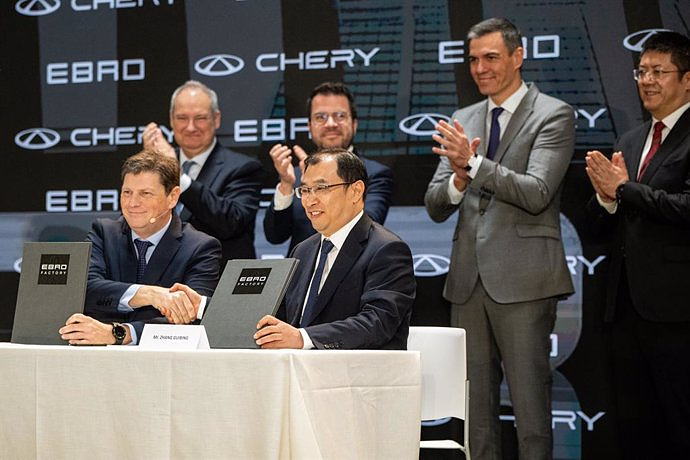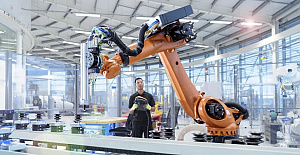in Germany, it is not an obvious market for electric vehicles. It is the home of the brandstofauto, the country is large, and the charging infrastructure is relatively limited. Still, the Germans were on the stekkerauto have to get used to, and not in the least because of the flood of plug-in inhybride of the models on their own soil. Do aanschafsubsidies the rest of it?
Just as it is in many other countries, the coronacrisis the car in Germany for a good bite is given. In may, it was the number of registrations are a lot lower than in the previous year. Last month went 168.148 of new passenger cars registered a decline of 49.5 percent of the time.
The number of stekkerauto, that is to say, all-electric models and in a vehicle with a plug-in inhybrideaandrijflijn (PHEV), fell in may, with a 12.333 pcs just 56 per cent higher than a year earlier. A little less than half of that, 5.578, copies, and were all-electric. The other models were the so-called phevs.
This dropped the number of records of phevs in at a whopping 107 percent higher compared to the same month in 2019.
Also the Audi's came in for the last few months with the new PHEV models. (Photo: Audi)
Manufacturers would do well to stekkerauto to contribute
to The attention of, especially for phevs to have a significant part as a result of the large number of new German models, with a plug-in inhybrideaandrijflijn. With Audi, you now have the choice of six, with BMW's eight-and-Mercedes-Benz of seven phevs. Also for Opel / vauxhall, Porsche, and Volkswagen, you can go for such a car.
a Lot of these models have been made in the last twelve months will be presented. This has a lot to do with the fact that the manufacturers of power necessary to get to the more stringent Eu CO2 regulations to comply with.
as of 1 January of this year, which is the limit of the average vlootuitstoot be reduced to be reduced to 95 grams per kilometer. The manufacturer is above, then the company is a high penalty to waiting.
the Car, which is less than 50 grams per kilometer of emissions (that is, the BEVS'and phevs) are, namely, a super-credits. This is a lucrative opportunity. This year should be a car that is less than 50 grams, about double-counting, the next year, he is 1.67, and in 2022, it is still up for 1,33-sold the cars. This is intended to encourage the development of the BEVS and phevs.
, the First driving test: Stekkerhybride of the Opel / vauxhall the Big aanschafsubsidie on the horizonThe increased demand for fully-and partially-electric car in Germany, it is not so much the past month. The trend has been for a number of years to be visible, but it is in the year 2020, in spite of the coronacrisis, rapidly. In the first five months, there have been 43% greater all-electric cars are sold, and it was 184 per cent, more PHEVs.
in Addition, the German consumers by July 1, the higher aanschafsubsidies tegemoetzien, so that the question may have to put it on. All the more so later in the year as well as the long-awaited-electric, Volkswagen, ID.3 is going to be delivered.
The grant is for the purchase of an all-electric model, has doubled to 6,000 euros. For the phevs, it is up to 4500 euros, while the people who are interested in hydrogen cars with fuel cells are able to count on a aanschafsubsidies (5,000 euros).
The figures are part of a package of economic support measures by the German government. This is also a requirement for German service stations to become charging stations for electric cars are to be put. Can receive a fee from the government.
In this way, the number of charging stations has expanded to. In germany, employs about 25,000 stations, which is less than half of the total number in the Netherlands. And to think that the country is more than eight times as large. According to the German authorities, there are at least 70,000 of the ordinary charging stations are needed, and about 7,000 so-called speed loaders.
In september, the first models of the vw is ID.3 be delivered. (Photo: Volkswagen).

 Exploring Cardano: Inner Workings and Advantages of this Cryptocurrency
Exploring Cardano: Inner Workings and Advantages of this Cryptocurrency Seville.- Economy.- Innova.- STSA inaugurates its new painting and sealing hangar in San Pablo, for 18 million
Seville.- Economy.- Innova.- STSA inaugurates its new painting and sealing hangar in San Pablo, for 18 million Innova.- More than 300 volunteers join the Andalucía Compromiso Digital network in one month to facilitate access to ICT
Innova.- More than 300 volunteers join the Andalucía Compromiso Digital network in one month to facilitate access to ICT Innova.-AMP.- Ayesa acquires 51% of Sadiel, which will create new technological engineering products and expand markets
Innova.-AMP.- Ayesa acquires 51% of Sadiel, which will create new technological engineering products and expand markets The Prosecutor's Office requests that the AN investigate the detainee for terrorism for damaging an ax in a McDonalds in Badalona
The Prosecutor's Office requests that the AN investigate the detainee for terrorism for damaging an ax in a McDonalds in Badalona Balearic PSOE denounces the director of IbSalut for prevarication for renouncing the mask claim file
Balearic PSOE denounces the director of IbSalut for prevarication for renouncing the mask claim file Otxandiano reproaches that PSOE "has lent itself" to taking out ETA in the campaign, like the extreme right against Sánchez
Otxandiano reproaches that PSOE "has lent itself" to taking out ETA in the campaign, like the extreme right against Sánchez Puigdemont claims to have a "well grasp" of the State and asks to "be respected" to obtain more transfers
Puigdemont claims to have a "well grasp" of the State and asks to "be respected" to obtain more transfers How Blockchain in being used to shape the future
How Blockchain in being used to shape the future Not just BTC and ETH: Here Are Some More Interesting Coins Worth Focusing on
Not just BTC and ETH: Here Are Some More Interesting Coins Worth Focusing on Valencia displays its "innovative and technological potential" at the Emerge Americas event in Miami
Valencia displays its "innovative and technological potential" at the Emerge Americas event in Miami The CSIC incorporates the challenges of robotics, nanotechnology and AI in the new strategic plan for biomedicine
The CSIC incorporates the challenges of robotics, nanotechnology and AI in the new strategic plan for biomedicine Innovation allocates 9.1 million to train 74,000 people and guarantee digital inclusion
Innovation allocates 9.1 million to train 74,000 people and guarantee digital inclusion LIFE SPOT manages to develop new green treatments that eliminate groundwater contamination
LIFE SPOT manages to develop new green treatments that eliminate groundwater contamination A million people demonstrate in France against Macron's pension reform
A million people demonstrate in France against Macron's pension reform Russia launches several missiles against "critical infrastructure" in the city of Zaporizhia
Russia launches several missiles against "critical infrastructure" in the city of Zaporizhia A "procession" remembers the dead of the Calabria shipwreck as bodies continue to wash up on the shore
A "procession" remembers the dead of the Calabria shipwreck as bodies continue to wash up on the shore Prison sentences handed down for three prominent Hong Kong pro-democracy activists
Prison sentences handed down for three prominent Hong Kong pro-democracy activists ETH continues to leave trading platforms, Ethereum balance on exchanges lowest in 3 years
ETH continues to leave trading platforms, Ethereum balance on exchanges lowest in 3 years Investors invest $450 million in Consensys, Ethereum incubator now valued at $7 billion
Investors invest $450 million in Consensys, Ethereum incubator now valued at $7 billion Alchemy Integrates Ethereum L2 Product Starknet to Enhance Web3 Scalability at a Price 100x Lower Than L1 Fees
Alchemy Integrates Ethereum L2 Product Starknet to Enhance Web3 Scalability at a Price 100x Lower Than L1 Fees Mining Report: Bitcoin's Electricity Consumption Declines by 25% in Q1 2022
Mining Report: Bitcoin's Electricity Consumption Declines by 25% in Q1 2022 Oil-to-Bitcoin Mining Firm Crusoe Energy Systems Raised $505 Million
Oil-to-Bitcoin Mining Firm Crusoe Energy Systems Raised $505 Million Microbt reveals the latest Bitcoin mining rigs -- Machines produce up to 126 TH/s with custom 5nm chip design
Microbt reveals the latest Bitcoin mining rigs -- Machines produce up to 126 TH/s with custom 5nm chip design Bitcoin's Mining Difficulty Hits a Lifetime High, With More Than 90% of BTC Supply Issued
Bitcoin's Mining Difficulty Hits a Lifetime High, With More Than 90% of BTC Supply Issued The Biggest Movers are Near, EOS, and RUNE during Friday's Selloff
The Biggest Movers are Near, EOS, and RUNE during Friday's Selloff Global Markets Spooked by a Hawkish Fed and Covid, Stocks and Crypto Gain After Musk Buys Twitter
Global Markets Spooked by a Hawkish Fed and Covid, Stocks and Crypto Gain After Musk Buys Twitter Bitso to offset carbon emissions from the Trading Platform's ERC20, ETH, and BTC Transactions
Bitso to offset carbon emissions from the Trading Platform's ERC20, ETH, and BTC Transactions Draftkings Announces 2022 College Hoops NFT Selection for March Madness
Draftkings Announces 2022 College Hoops NFT Selection for March Madness


























